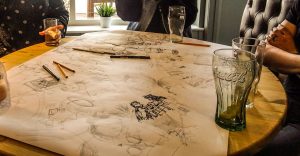There are numerous definitions of drawing. Here, I’ll work with the basic definition: that drawing is when a point moves on a surface, leaving a mark. A typical drawing tool is a pen or pencil onto a paper. Drawing can be integrated into taught sessions in a variety of ways. Pens and paper are easily sourced, cheap material. From experience, those unaccustomed to drawing are more comfortable with ballpoint pens and felt tips compared to graphite pencils. Here are some examples of fast or quick drawings.
Blind drawings are quick fun drawings that are relaxed as no one expects them to be ‘perfect’ drawings. In this situation, the person draws with a continuous line while focusing on an object or environment without looking at their evolving drawing. As an icebreaker try getting students in pairs doing a blind drawing of each other. To provoke critical thinking about the familiar, the person can also try to draw their own face by touch alone. They trace across their face with one hand and draw with the other, again not looking at the page.
Expanding this up, blind drawing also can situate students rapidly into a sense of place by capturing the surrounding environment. For example, getting students to draw, without looking at their page, their surroundings of a simulated ward or on a field trip. These are all types of haptic drawing where the drawing hand attempts to replicate what either the eye or indeed the feeling hand “sees”. Though not accurate renditions they rapidly capture a sense of character about a person or place.
Lines quickly embodies felt experience too, useful in teaching and research scenarios. Before going through an exam preparation session with a group, I ask students to quickly generate a line on how they are feeling. Their small drawings are pooled in the centre for students to see and can be repeated at the end. Use fast drawings to prompt group discussion like Lily Orland, who was surprised by student teachers’ recall of a session when they drew a ‘felt experience’ of teaching that led to further group discussion and reflection. This can be up-scaled such as in Drawing Energy, where the public were to draw what energy looked like.
Quick drawings can be collaborative too. We sat around a table and drew things within our field of vision onto the same page. After two minutes we moved clockwise and repeated the process, this time interacting with previous drawings on the page. As the group reflected, we realised how many objects in our environment we had overlooked.

Drawings take very little time and comprise a great deal of information. Let me know if and how you draw with students. In the next post, I will give some examples on spending longer to create slow drawings.









Interesting stuff! As part of my 1st yr unit Practical Skills in Geography I develop student’s skills in field sketching. This is an essential part of Geography fieldwork, but also encourages the students to experience and interpret the landscape in real time, which creates a deeper understanding and greater learning experience than simply taking a photograph.
thanks Andy, would be interesting to hear more about this. how do students respond to drawing? What alternatives are there in poor weather situations? do some take a photo to draw from later?